technical data FIAT QUBO 2017 1.G Owners Manual
[x] Cancel search | Manufacturer: FIAT, Model Year: 2017, Model line: QUBO, Model: FIAT QUBO 2017 1.GPages: 260, PDF Size: 4.74 MB
Page 106 of 260
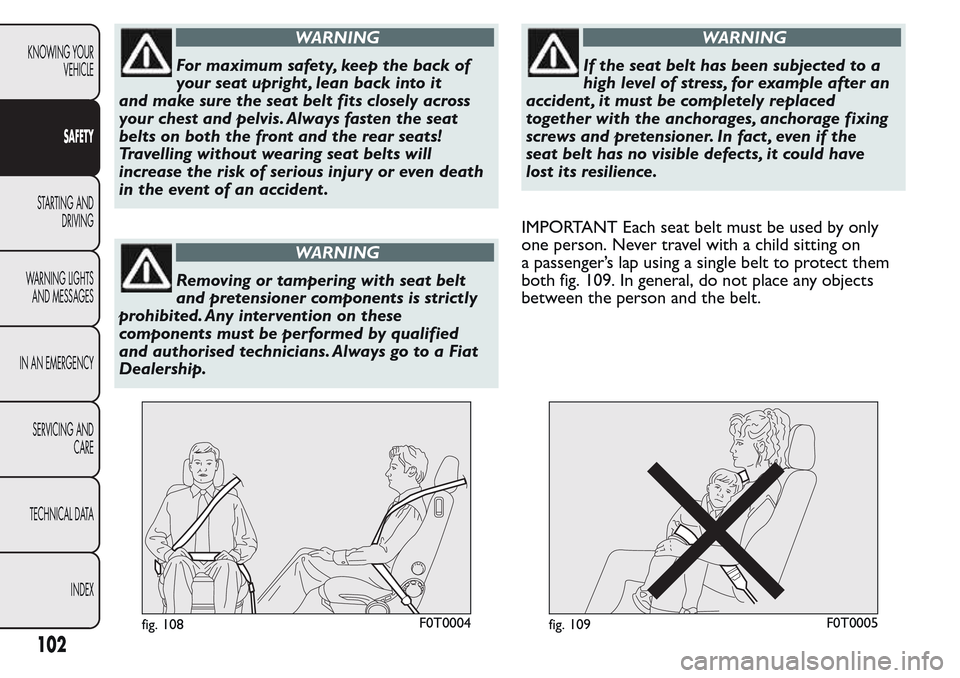
WARNING
For maximum safety, keep the back of
your seat upright , lean back into it
and make sure the seat belt fits closely across
your chest and pelvis. Always fasten the seat
belts on both the front and the rear seats!
Travelling without wearing seat belts will
increase the risk of serious injur y or even death
in the event of an accident .
WARNING
Removing or tampering with seat belt
and pretensioner components is strictly
prohibited. Any intervention on these
components must be performed by qualified
and authorised technicians. Always go to a Fiat
Dealership.
WARNING
If the seat belt has been subjected to a
high level of stress, for example after an
accident , it must be completely replaced
together with the anchorages, anchorage fixing
screws and pretensioner. In fact , even if the
seat belt has no visible defects, it could have
lost its resilience.
IMPORTANT Each seat belt must be used by only
one person. Never travel with a child sitting on
a passenger’s lap using a single belt to protect them
both fig. 109. In general, do not place any objects
between the person and the belt.
fig. 108F0T0004fig. 109F0T0005
102
KNOWING YOUR
VEHICLE
SAFETY
STARTING AND
DRIVING
WARNING LIGHTS
AND MESSAGES
IN AN EMERGENCY
SERVICING AND
CARE
TECHNICAL DATA
INDEX
Page 107 of 260
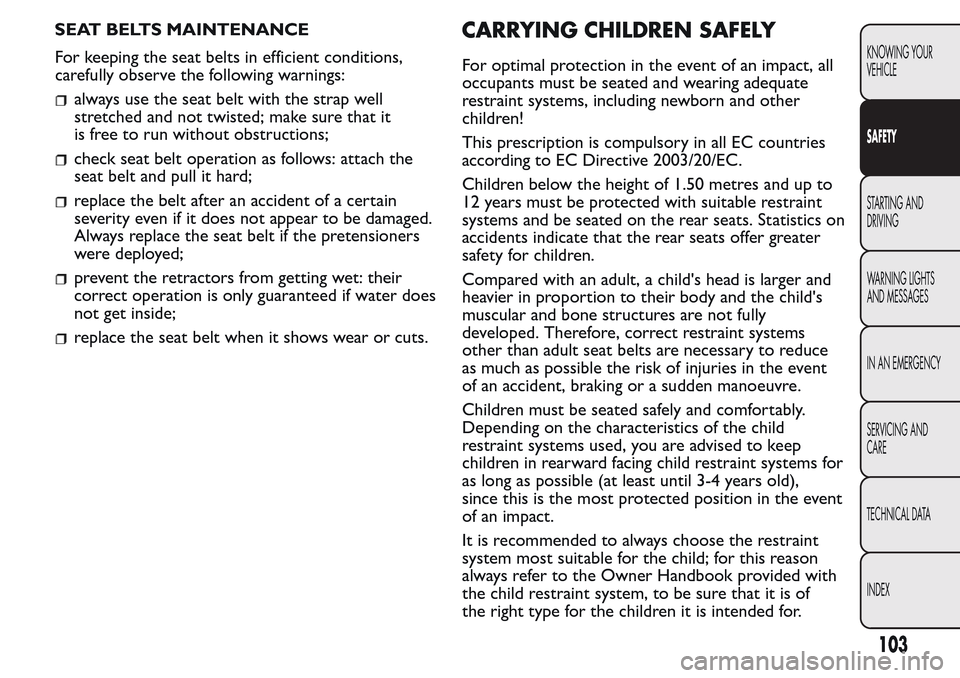
SEAT BELTS MAINTENANCE
For keeping the seat belts in efficient conditions,
carefully observe the following warnings:
always use the seat belt with the strap well
stretched and not twisted; make sure that it
is free to run without obstructions;
check seat belt operation as follows: attach the
seat belt and pull it hard;
replace the belt after an accident of a certain
severity even if it does not appear to be damaged.
Always replace the seat belt if the pretensioners
were deployed;
prevent the retractors from getting wet: their
correct operation is only guaranteed if water does
not get inside;
replace the seat belt when it shows wear or cuts.
CARRYING CHILDREN SAFELY
For optimal protection in the event of an impact, all
occupants must be seated and wearing adequate
restraint systems, including newborn and other
children!
This prescription is compulsory in all EC countries
according to EC Directive 2003/20/EC.
Children below the height of 1.50 metres and up to
12 years must be protected with suitable restraint
systems and be seated on the rear seats. Statistics on
accidents indicate that the rear seats offer greater
safety for children.
Compared with an adult, a child's head is larger and
heavier in proportion to their body and the child's
muscular and bone structures are not fully
developed. Therefore, correct restraint systems
other than adult seat belts are necessary to reduce
as much as possible the risk of injuries in the event
of an accident, braking or a sudden manoeuvre.
Children must be seated safely and comfortably.
Depending on the characteristics of the child
restraint systems used, you are advised to keep
children in rearward facing child restraint systems for
as long as possible (at least until 3-4 years old),
since this is the most protected position in the event
of an impact.
It is recommended to always choose the restraint
system most suitable for the child; for this reason
always refer to the Owner Handbook provided with
the child restraint system, to be sure that it is of
the right type for the children it is intended for.
103
KNOWING YOUR
VEHICLE
SAFETY
STARTING AND
DRIVING
WARNING LIGHTS
AND MESSAGES
IN AN EMERGENCY
SERVICING AND
CARE
TECHNICAL DATA
INDEX
Page 108 of 260
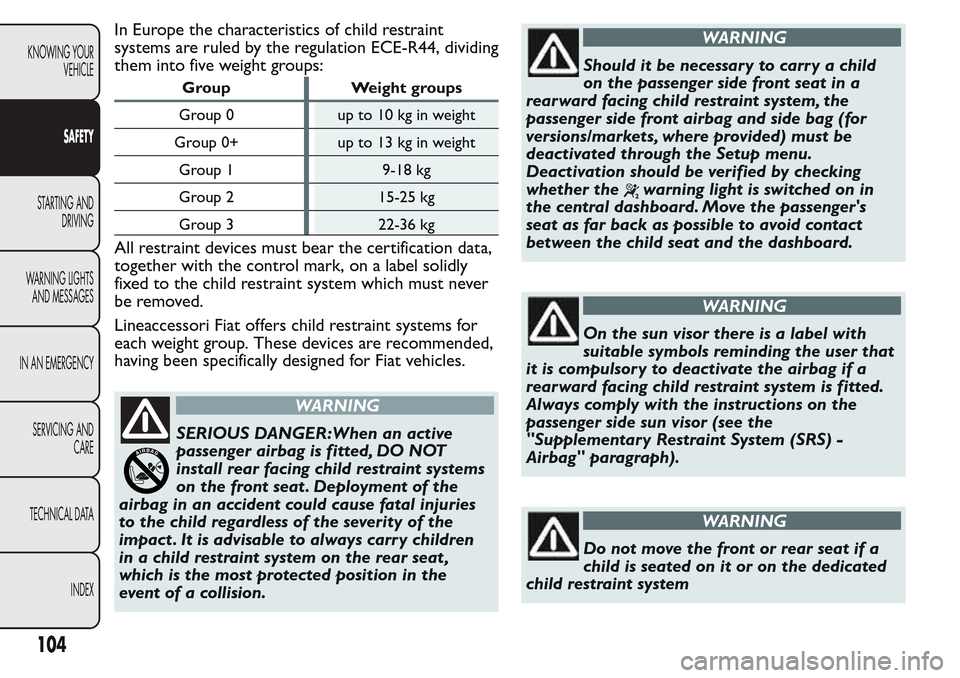
In Europe the characteristics of child restraint
systems are ruled by the regulation ECE-R44, dividing
them into five weight groups:
Group Weight groups
Group 0 up to 10 kg in weight
Group 0+ up to 13 kg in weight
Group 1 9-18 kg
Group 2 15-25 kg
Group 3 22-36 kg
All restraint devices must bear the certification data,
together with the control mark, on a label solidly
fixed to the child restraint system which must never
be removed.
Lineaccessori Fiat offers child restraint systems for
each weight group. These devices are recommended,
having been specifically designed for Fiat vehicles.
WARNING
SERIOUS DANGER:When an active
passenger airbag is fitted, DO NOT
install rear facing child restraint systems
on the front seat . Deployment of the
airbag in an accident could cause fatal injuries
to the child regardless of the severity of the
impact . It is advisable to always carr y children
in a child restraint system on the rear seat ,
which is the most protected position in the
event of a collision.
WARNING
Should it be necessary to carry a child
on the passenger side front seat in a
rearward facing child restraint system, the
passenger side front airbag and side bag (for
versions/markets, where provided) must be
deactivated through the Setup menu.
Deactivation should be verified by checking
whether the
warning light is switched on in
the central dashboard. Move the passenger's
seat as far back as possible to avoid contact
between the child seat and the dashboard.
WARNING
On the sun visor there is a label with
suitable symbols reminding the user that
it is compulsory to deactivate the airbag if a
rearward facing child restraint system is fitted.
Always comply with the instructions on the
passenger side sun visor (see the
"Supplementar y Restraint System (SRS) -
Airbag" paragraph).
WARNING
Do not move the front or rear seat if a
child is seated on it or on the dedicated
child restraint system
104
KNOWING YOUR
VEHICLE
SAFETY
STARTING AND
DRIVING
WARNING LIGHTS
AND MESSAGES
IN AN EMERGENCY
SERVICING AND
CARE
TECHNICAL DATA
INDEX
Page 109 of 260
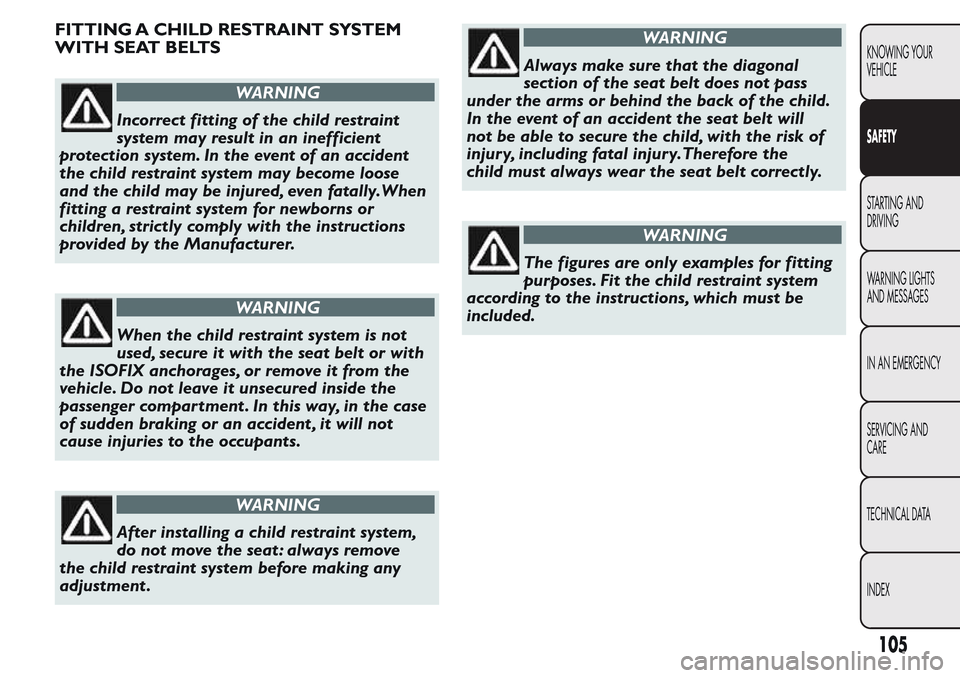
FITTING A CHILD RESTRAINT SYSTEM
WITH SEAT BELTS
WARNING
Incorrect fitting of the child restraint
system may result in an inefficient
protection system. In the event of an accident
the child restraint system may become loose
and the child may be injured, even fatally.When
fitting a restraint system for newborns or
children, strictly comply with the instructions
provided by the Manufacturer.
WARNING
When the child restraint system is not
used, secure it with the seat belt or with
the ISOFIX anchorages, or remove it from the
vehicle. Do not leave it unsecured inside the
passenger compar tment . In this way, in the case
of sudden braking or an accident , it will not
cause injuries to the occupants.
WARNING
After installing a child restraint system,
do not move the seat : always remove
the child restraint system before making any
adjustment .
WARNING
Always make sure that the diagonal
section of the seat belt does not pass
under the arms or behind the back of the child.
In the event of an accident the seat belt will
not be able to secure the child, with the risk of
injury, including fatal injury.Therefore the
child must always wear the seat belt correctly.
WARNING
The figures are only examples for fitting
purposes. Fit the child restraint system
according to the instructions, which must be
included.
105
KNOWING YOUR
VEHICLE
SAFETY
STARTING AND
DRIVING
WARNING LIGHTS
AND MESSAGES
IN AN EMERGENCY
SERVICING AND
CARE
TECHNICAL DATA
INDEX
Page 110 of 260
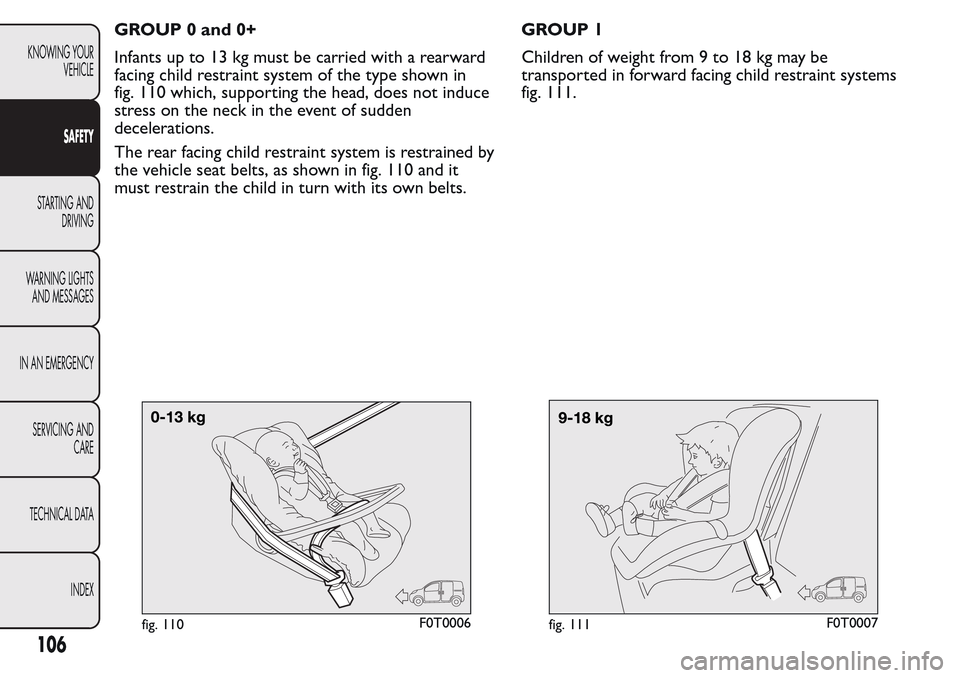
GROUP 0 and 0+
Infants up to 13 kg must be carried with a rearward
facing child restraint system of the type shown in
fig. 110 which, supporting the head, does not induce
stress on the neck in the event of sudden
decelerations.
The rear facing child restraint system is restrained by
the vehicle seat belts, as shown in fig. 110 and it
must restrain the child in turn with its own belts.GROUP 1
Children of weight from 9 to 18 kg may be
transported in forward facing child restraint systems
fig. 111.
fig. 110F0T0006fig. 111F0T0007
106
KNOWING YOUR
VEHICLE
SAFETY
STARTING AND
DRIVING
WARNING LIGHTS
AND MESSAGES
IN AN EMERGENCY
SERVICING AND
CARE
TECHNICAL DATA
INDEX
Page 111 of 260
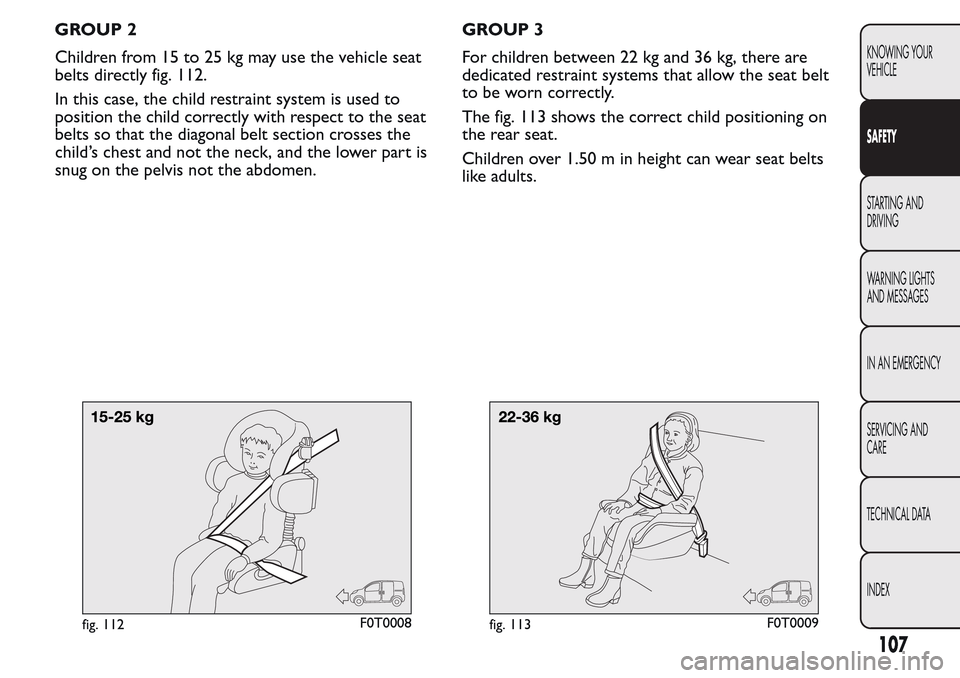
GROUP 2
Children from 15 to 25 kg may use the vehicle seat
belts directly fig. 112.
In this case, the child restraint system is used to
position the child correctly with respect to the seat
belts so that the diagonal belt section crosses the
child’s chest and not the neck, and the lower part is
snug on the pelvis not the abdomen.GROUP 3
For children between 22 kg and 36 kg, there are
dedicated restraint systems that allow the seat belt
to be worn correctly.
The fig. 113 shows the correct child positioning on
the rear seat.
Children over 1.50 m in height can wear seat belts
like adults.
fig. 112F0T0008fig. 113F0T0009
107
KNOWING YOUR
VEHICLE
SAFETY
STARTING AND
DRIVING
WARNING LIGHTS
AND MESSAGES
IN AN EMERGENCY
SERVICING AND
CARE
TECHNICAL DATA
INDEX
Page 112 of 260
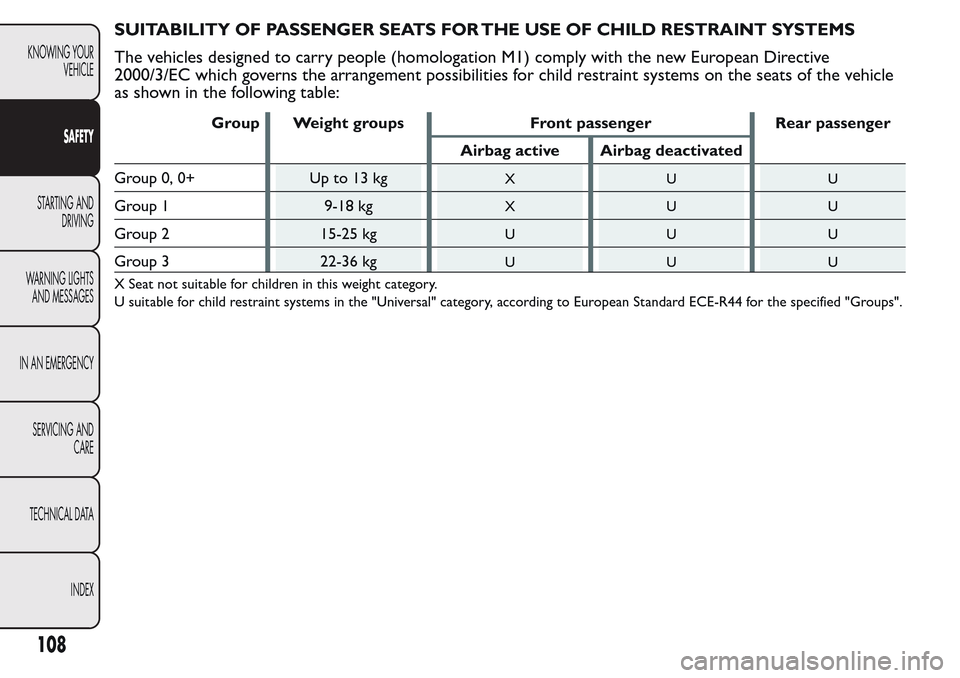
SUITABILITY OF PASSENGER SEATS FOR THE USE OF CHILD RESTRAINT SYSTEMS
The vehicles designed to carry people (homologation M1) comply with the new European Directive
2000/3/EC which governs the arrangement possibilities for child restraint systems on the seats of the vehicle
as shown in the following table:
Group Weight groups Front passenger Rear passenger
Airbag active Airbag deactivated
Group 0, 0+ Up to 13 kg
XUU
Group 1 9-18 kgXUU
Group 2 15-25 kgUUU
Group 3 22-36 kgUUU
X Seat not suitable for children in this weight category.
U suitable for child restraint systems in the "Universal" category, according to European Standard ECE-R44 for the specified "Groups".
108
KNOWING YOUR
VEHICLE
SAFETY
STARTING AND
DRIVING
WARNING LIGHTS
AND MESSAGES
IN AN EMERGENCY
SERVICING AND
CARE
TECHNICAL DATA
INDEX
Page 113 of 260
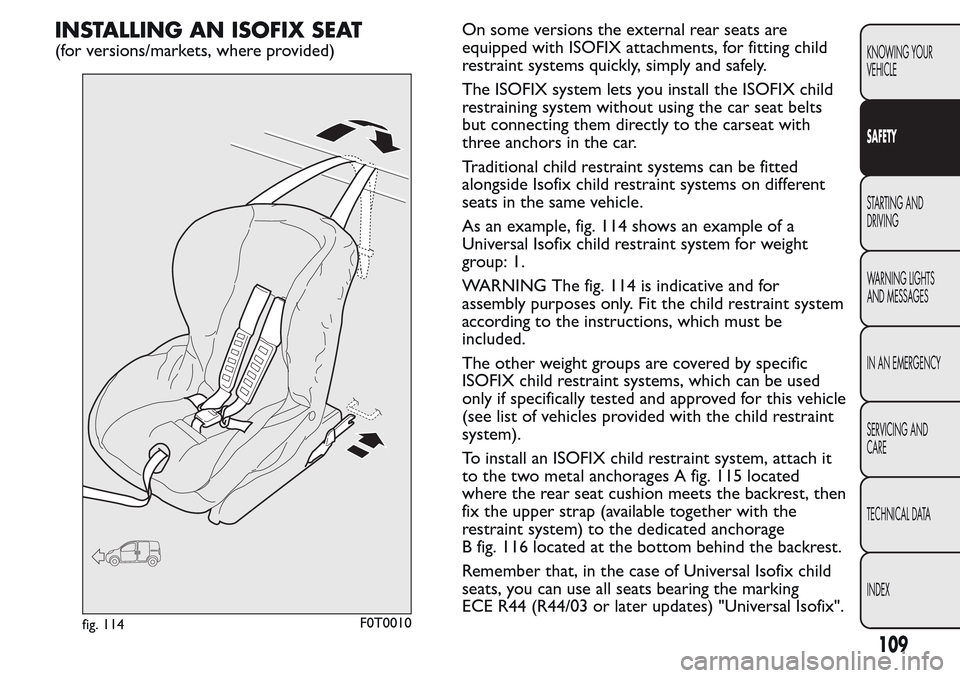
INSTALLING AN ISOFIX SEAT
(for versions/markets, where provided)On some versions the external rear seats are
equipped with ISOFIX attachments, for fitting child
restraint systems quickly, simply and safely.
The ISOFIX system lets you install the ISOFIX child
restraining system without using the car seat belts
but connecting them directly to the carseat with
three anchors in the car.
Traditional child restraint systems can be fitted
alongside Isofix child restraint systems on different
seats in the same vehicle.
As an example, fig. 114 shows an example of a
Universal Isofix child restraint system for weight
group: 1.
WARNING The fig. 114 is indicative and for
assembly purposes only. Fit the child restraint system
according to the instructions, which must be
included.
The other weight groups are covered by specific
ISOFIX child restraint systems, which can be used
only if specifically tested and approved for this vehicle
(see list of vehicles provided with the child restraint
system).
To install an ISOFIX child restraint system, attach it
to the two metal anchorages A fig. 115 located
where the rear seat cushion meets the backrest, then
fix the upper strap (available together with the
restraint system) to the dedicated anchorage
B fig. 116 located at the bottom behind the backrest.
Remember that, in the case of Universal Isofix child
seats, you can use all seats bearing the marking
ECE R44 (R44/03 or later updates) "Universal Isofix".
fig. 114F0T0010
109
KNOWING YOUR
VEHICLE
SAFETY
STARTING AND
DRIVING
WARNING LIGHTS
AND MESSAGES
IN AN EMERGENCY
SERVICING AND
CARE
TECHNICAL DATA
INDEX
Page 114 of 260
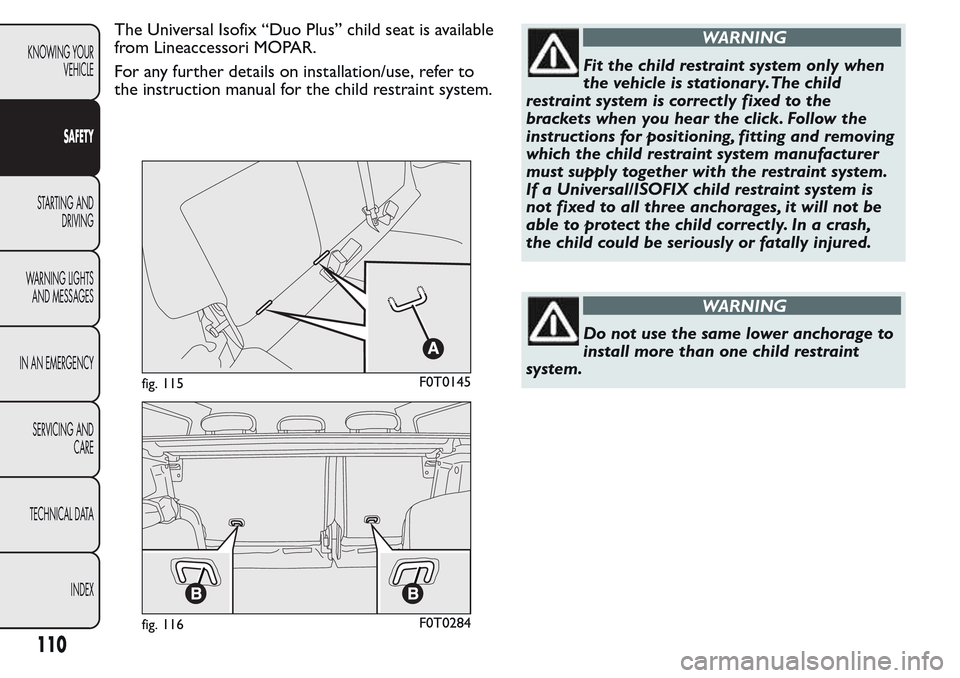
The Universal Isofix “Duo Plus” child seat is available
from Lineaccessori MOPAR.
For any further details on installation/use, refer to
the instruction manual for the child restraint system.WARNING
Fit the child restraint system only when
the vehicle is stationary.The child
restraint system is correctly fixed to the
brackets when you hear the click. Follow the
instructions for positioning, fitting and removing
which the child restraint system manufacturer
must supply together with the restraint system.
If a Universal/ISOFIX child restraint system is
not fixed to all three anchorages, it will not be
able to protect the child correctly. In a crash,
the child could be seriously or fatally injured.
WARNING
Donotusethesameloweranchorageto
install more than one child restraint
system.
fig. 115F0T0145
fig. 116F0T0284
110
KNOWING YOUR
VEHICLE
SAFETY
STARTING AND
DRIVING
WARNING LIGHTS
AND MESSAGES
IN AN EMERGENCY
SERVICING AND
CARE
TECHNICAL DATA
INDEX
Page 115 of 260
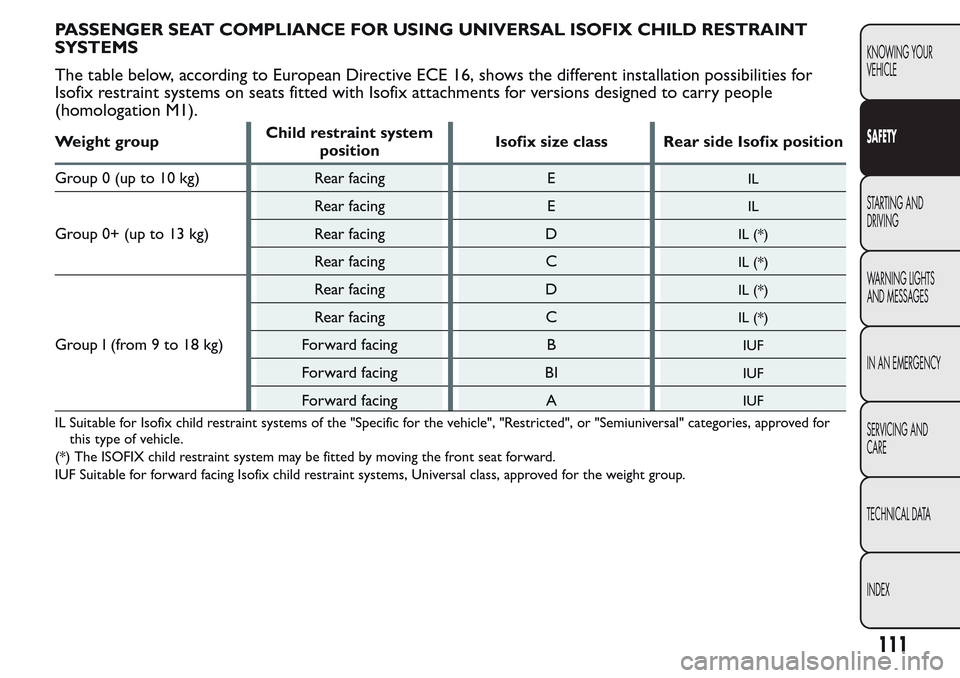
PASSENGER SEAT COMPLIANCE FOR USING UNIVERSAL ISOFIX CHILD RESTRAINT
SYSTEMS
The table below, according to European Directive ECE 16, shows the different installation possibilities for
Isofix restraint systems on seats fitted with Isofix attachments for versions designed to carry people
(homologation M1).
Weight groupChild restraint system
positionIsofix size class Rear side Isofix position
Group 0 (up to 10 kg) Rear facing E
IL
Group 0+ (up to 13 kg)Rear facing E
IL
Rear facing DIL (*)
Rear facing CIL (*)
GroupI(from9to18kg)Rear facing D
IL (*)
Rear facing CIL (*)
Forward facing BIUF
Forward facing BIIUF
Forward facing AIUF
IL Suitable for Isofix child restraint systems of the "Specific for the vehicle", "Restricted", or "Semiuniversal" categories, approved for
this type of vehicle.
(*) The ISOFIX child restraint system may be fitted by moving the front seat forward.
IUF Suitable for forward facing Isofix child restraint systems, Universal class, approved for the weight group.
111
KNOWING YOUR
VEHICLE
SAFETY
STARTING AND
DRIVING
WARNING LIGHTS
AND MESSAGES
IN AN EMERGENCY
SERVICING AND
CARE
TECHNICAL DATA
INDEX